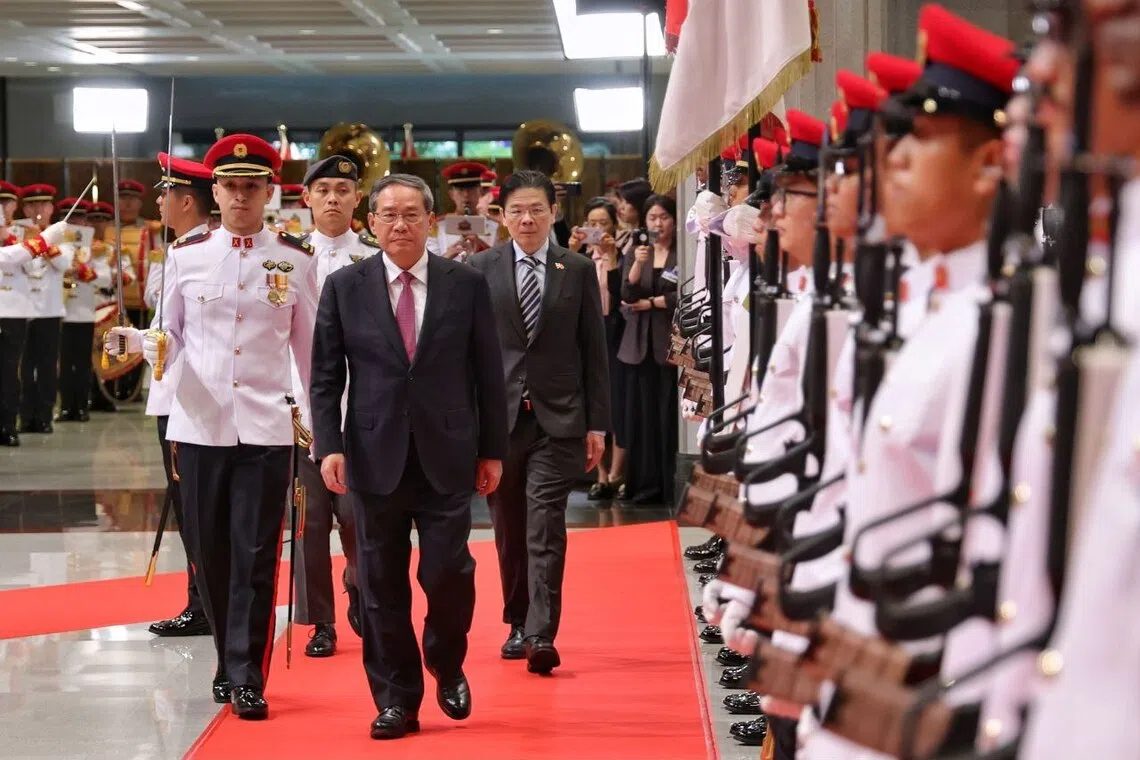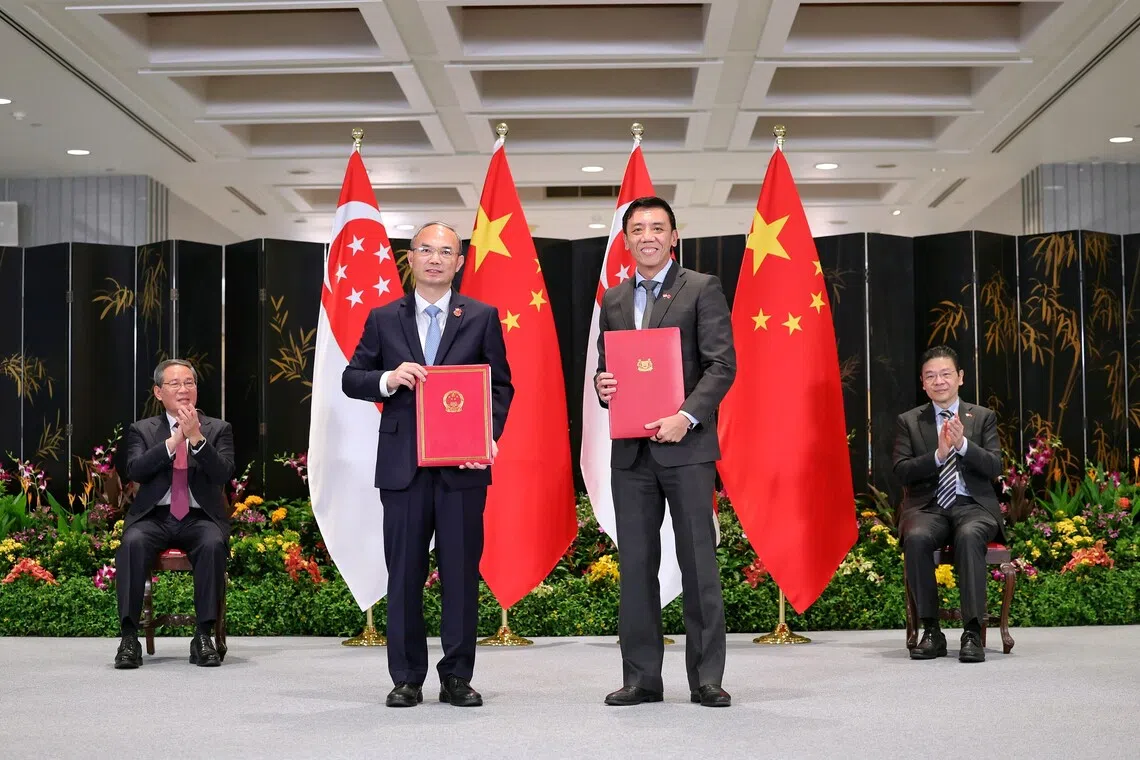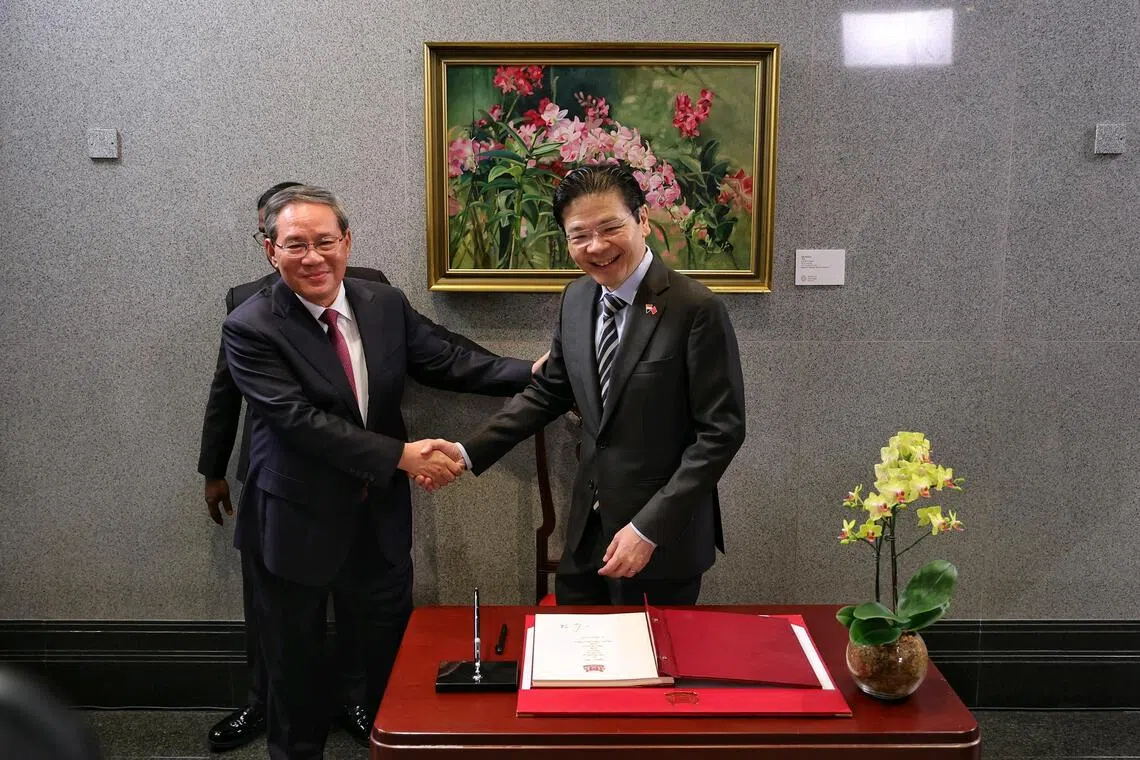S’pore, China to establish national green and digital shipping corridor; pledge to deepen ties
Sign up now: Get ST's newsletters delivered to your inbox

Prime Minister Lawrence Wong (right) welcoming Chinese Premier Li Qiang at Parliament House on Oct 25.
ST PHOTO: KEVIN LIM
Follow topic:
SINGAPORE – Singapore and China have agreed to work together to decarbonise and digitalise shipping routes between the two countries, with the establishment of a national green and digital shipping corridor.
This memorandum of understanding (MOU) is one of eight agreements exchanged on Oct 25 during an official visit by Chinese Premier Li Qiang, as Singapore and China pledged to deepen cooperation and bilateral ties.
Mr Li, who is visiting Singapore for the first time as Premier, at the invitation of Prime Minister Lawrence Wong, was welcomed by a guard of honour at Parliament House.
In his opening remarks during a meeting between the delegations of both sides, PM Wong said: “We would like to see how we can deepen our cooperation further, and also how we can work together to uphold the key principles of free trade and the rules-based multilateral order.”
Mr Li said during his meeting with PM Wong that he looked forward to further deepening China-Singapore ties during his visit here – the first by a Chinese premier in seven years.
Mr Li added that China is willing to work with Singapore to better serve the modernisation of both countries, and make greater contributions to the peaceful and stable development of the region.
In a statement issued on his arrival in Singapore, Mr Li said relations between the two countries have maintained a sound momentum of growth. He noted the upgrade of China-Singapore ties in 2023 at a meeting in June 2025
During their meeting on Oct 25, PM Wong and Mr Li agreed to further strengthen trade and investment links between the two countries.
Mr Li updated PM Wong on the latest developments in China, including the outcomes of the recently concluded Fourth Plenum
PM Wong, meanwhile, expressed Singapore’s confidence in China’s overall long-term trajectory and development prospects.
Singapore’s Ministry of Foreign Affairs (MFA) said the leaders also exchanged views on regional and international issues.
PM Wong expressed support for China’s Global Development Initiative (GDI) and Singapore’s readiness to collaborate with countries in Beijing’s GDI “Group of Friends”.
Put forward by President Xi in 2021, the GDI is China’s vision of helping developing countries meet the United Nations 2030 Agenda for Sustainable Development, by providing support in areas such as climate change and food security.
PM Wong and Mr Li also discussed cross-strait developments during their Oct 25 meeting.

Chinese Premier Li Qiang (front, centre), who is visiting Singapore for the first time as Premier and at the invitation of Prime Minister Lawrence Wong, was welcomed by a guard of honour at Parliament House on Oct 25.
ST PHOTO: KEVIN LIM
MFA said PM Wong reiterated that Singapore has a clear and consistent “One China” policy and is opposed to Taiwan independence.
The planned national shipping corridor between Singapore and China is an elevation of current arrangements between the Republic and Tianjin municipality, as well as with Shandong province, to test digital solutions and alternative fuels on trade routes.
Under the Singapore-Tianjin corridor, both sides have started joint research on adopting green methanol, a lower-emissions fuel for ships. With Shandong, one of the focus areas is on the exchange of digital information to facilitate port clearances.
Tianjin is home to the largest port in northern China, while Shandong is China’s second most populous province and hosts one of the world’s busiest container ports in Qingdao.
The latest agreement between Singapore and China will add to a growing global network of so-called “green and digital shipping corridors”, of which the Republic has seven today.

Acting Transport Minister Jeffrey Siow (centre, right) and Chinese ambassador to Singapore Cao Zhongming (centre, left) oversaw the exchange of MOU on the Singapore-China Green and Digital Shipping Corridor on Oct 25.
ST PHOTO: KEVIN LIM
In addition to those with Tianjin and Shandong, Singapore has similar shipping corridors with the ports in Los Angeles and Long Beach in the US, and the port of Rotterdam in the Netherlands.
At the national level, the Republic also has green and digital shipping corridors with Japan and Australia, and it recently agreed in September to establish one with India.
Since 2013, China has been Singapore’s largest goods trading partner, with total bilateral trade in 2024 amounting to $170 billion, a 1.8 per cent increase from 2023.
Six of the world’s 10 largest container ports by volume are located in the Chinese mainland.
Other bilateral MOUs exchanged on Mr Li’s first day in Singapore include an agreement between the two countries to jointly develop a training programme for government officials from the 10 Asean member states, as well as Timor-Leste, soon to be the 11th member.
Both sides had earlier signed a letter of intent to develop such a programme when PM Wong made an introductory visit to China in June 2025, his first outside of South-east Asia after taking over as head of government in May 2024.
The training programme will focus on areas such as clean energy transition, sustainable urban development and climate resilience.
It will also support the Asean Power Grid
Another MOU will see Singapore and China cooperate on emergency management, with both sides to exchange knowledge and expertise in firefighting, rescue and disaster management.
Singapore and China have also agreed to enhance their cooperation in green development and the digital economy, building on earlier pacts that were inked in 2022.
Existing MOUs on food safety and information and communications technology were also renewed and updated.
With the new agreements, more business collaboration will be encouraged, including in new areas such as carbon trading, carbon capture and low-carbon hydrogen.
Both countries will also work closer together in areas such as digital trade and the sharing of best practices in relation to digital economy regulations and policies.

Prime Minister Lawrence Wong (right) and Chinese Premier Li Qiang shaking hands after Mr Li signed the guestbook at Parliament House on Oct 25.
ST PHOTO: KEVIN LIM
The final MOU signed on Oct 25 will enhance the functions of a Singapore launchpad that facilitates two-way investments between Singapore and the Suzhou Industrial Park.
Under the MOU, both sides will jointly support the establishment of business cooperation centres in South-east Asia to promote Singapore as a gateway for the two-way flow of trade and investments between the region and China, as well as the two-way internationalisation of companies.
Mr Li’s visit to Singapore, which spans two days, comes as Singapore and China mark 35 years of diplomatic ties
As part of his visit, Mr Li will call on Acting President Eddie Teo, who is chairman of the Council of Presidential Advisers, on Oct 26, as President Tharman Shanmugaratnam is overseas on leave.
Mr Li will also meet with business leaders from Singapore and China at a Singapore-China Business Roundtable hosted by Deputy Prime Minister Gan Kim Yong, before leaving for Malaysia to attend the 47th Asean Summit in Kuala Lumpur.


